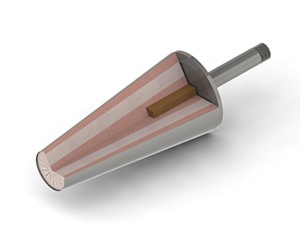How to build furnace and sintering process for intermediate frequency furnace lining materials
Knotted furnace bottom: the thickness of the furnace bottom is about 200mm-280mm, and the sand is filled in 2 to 3 times. When manually knotting, the density is not uneven everywhere, and the furnace lining after baking and sintering is not dense. Therefore, the thickness of the feeding must be strictly controlled. Generally, the thickness of sand filling is not more than 100mm\/time, and the furnace wall is controlled within 60mm. Multiple people are divided into shifts, 4-6 people per shift, and each time the knot is tied for 30 minutes. to avoid uneven density.
When the bottom of the furnace is knotted to the required height, it can be scraped flat, and then the crucible mold can be placed. In this regard, attention should be paid to ensure that the crucible mold and the induction coil are concentric, and the vertical adjustment is made vertically. It is clamped with 3 wooden wedges, and the middle hanging weight is pressed on to avoid the displacement of quartz sand when the furnace wall is knotted.
Knotting the furnace wall: the thickness of the furnace lining is 90mm-120mm, the dry knotting material is added in batches, the cloth is uniform, the thickness of the filler is not more than 60 mm, and the knot is knotted for 15 minutes (manual knotting) until it is flush with the upper edge of the induction coil. The crucible mold is not taken out after knotting, and induction heating is used during drying and sintering. If you want to take out the crucible mold, wrap 2-3 layers of newspaper on the outer wall of the crucible mold before knotting the furnace wall and wrap it tightly with tape. When the furnace wall is heated to 900 degrees, the crucible mold is quickly taken out after the newspaper smokes, and the iron barrel with a height of 10-15 cm smaller than the diameter of the crucible mold and the height of the furnace mouth is used for induction heating during drying and sintering.
Baking and sintering specifications: In order to obtain the 3-layer structure of the furnace lining, the baking and sintering process is roughly divided into 3 stages: it should be noted that iron pins and small iron materials must be used in the furnace during baking and sintering. Add chunks of iron, pointed, toothed iron.
Baking stage: heat the crucible mold to 900 degrees Celsius at a speed of 200 for 20 minutes, 300 for 20 minutes, and 400 for 20 minutes, and keep it for 20 minutes, the purpose is to completely remove the moisture in the furnace lining.
Semi-sintering stage: keep the temperature at 400 for 20 minutes, 500 for 20 minutes, and 600 for 20 minutes. The heating rate must be controlled to prevent cracks.
Complete sintering stage: high temperature sintering, the sintering structure of the crucible is the basis for improving its service life. The sintering temperature is different, the thickness of the sintered layer is insufficient, and the service life is significantly reduced.

Previous: Intermediate frequency furnace ramming material
下一条: Influence of medium frequency electric furnace lining material
Related Industry Knowledge
- Features and Benefits of Coil Clay
- What are the advantages of a good furnace lining
- Misunderstandings in the use of ramming materials in intermediate frequency furnaces
- Phenomenon analysis of failure of argon blowing of ladle permeable bricks and how to improve the rate of argon blowing
- Where is the consumption reduction and energy saving of breathable bricks reflected?
- How to improve the service life of intermediate frequency furnace lining
- Reasons for damage to intermediate frequency furnace lining and how to solve them
- The performance and advantages of breathable brick
- Analysis of Structural Characteristics of Dispersive Breathable Bricks
- The intermediate frequency furnace charge knotting process needs to pay attention to details sharing
- Intermediate frequency furnace ramming material
- How to properly maintain the furnace lining
- When the ramming material of the intermediate frequency furnace is in use, the molten steel has viscosity slag, how to solve it?
- Discussion on the Influence of Furnace Lining Material on the Production of Electric Casting Furnace
- The age of the ramming material in the intermediate frequency furnace is related to those factors
- What are the advantages and disadvantages of refractory ramming material?
- What are the characteristics of the application of refractory bricks
- Teach you how to improve the temperature resistance of the intermediate frequency furnace lining
- What are the types of ladle breathable bricks?
- Main components of refractory materials such as breathable bricks, nozzle block bricks, castables, etc.


